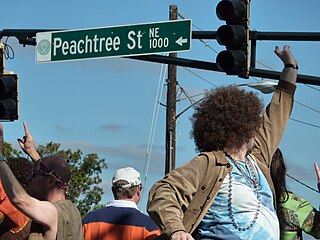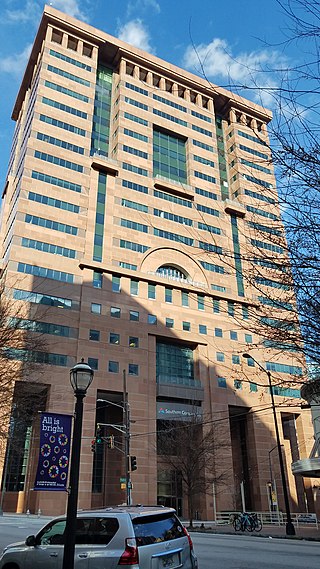
Peachtree Street is one of several major streets running through the city of Atlanta, Georgia, United States. Beginning at Five Points in downtown Atlanta, it runs North through Midtown; a few blocks after entering into Buckhead, the name changes to Peachtree Road at Deering Road. Much of the city's historic and noteworthy architecture is located along the street, and it is often used for annual parades,, as well as one-time parades celebrating events such as the 100th anniversary of Coca-Cola in 1986 and the Atlanta Braves' 1995 and 2021 World Series victories.

The Arcade in downtown Cleveland, Ohio, is a Victorian-era structure of two nine-story buildings, joined by a five-story arcade with a glass skylight spanning over 300 feet, along the four balconies. Erected in 1890, at a cost of $867,000, the Arcade opened on Memorial Day, and is identified as one of the earliest indoor shopping arcades in the United States. The Arcade was modified in 1939, remodeling the Euclid Avenue entrance and adding some structural support. It was designated a National Historic Landmark in 1975.

Five Points is a metro station of the Metropolitan Atlanta Rapid Transit Authority (MARTA) rail system in Atlanta, Georgia. It is the transfer point for all rail lines and serves as the main transportation hub for MARTA. It provides access to the Five Points Business District, Georgia State University, Underground Atlanta, City Hall, the Richard B. Russell Federal Building, CobbLinc, Ride Gwinnett, GRTA Xpress Transit, Station Soccer, and the tourism heart of Downtown Atlanta. It provides connecting bus service to Zoo Atlanta, Grant Park, Atlanta University Center, East Atlanta Village, Martin Luther King Jr. National Historical Park, Carter Center, Atlanta City Hall, South Dekalb Mall and Fulton County Government Center.

The historic 21-story Rhodes–Haverty Building was, at the time of its construction in 1929, the tallest building in Atlanta, Georgia. Designed by Atlanta architects Pringle and Smith, the building was built by furniture magnates A. G. Rhodes of Rhodes Furniture and J. J. Haverty of Havertys. It remained the tallest building in Atlanta until 1954.

The Shrine of the Immaculate Conception is a Roman Catholic church located at 48 Martin Luther King Jr. Drive SW in downtown Atlanta, Georgia, United States. The current church building was completed in 1873 and is the oldest church in Atlanta, as well as one of the oldest standing buildings in the city. It was added to the National Register of Historic Places in 1976.

The Basilica of the Sacred Heart of Jesus is a Roman Catholic church located at 353 Peachtree Street NE in downtown Atlanta, Georgia, United States. The current building was completed in 1898. It was added to the National Register of Historic Places in 1976 and was designated a minor basilica in 2010.

The Henry Grady Hotel was a hotel in downtown Atlanta, Georgia, United States. The building, designed by architect G. Lloyd Preacher, was completed in 1924 at the intersection of Peachtree Street and Cain Street, on land owned by the government of Georgia that had previously been occupied by the official residence of the governor. The hotel, which was named after journalist Henry W. Grady, was owned by the state and leased to operators. During the mid-1900s, the hotel typically served as the residence of state legislators during the legislative sessions, and it was an important location for politicking, with President Jimmy Carter later saying, "[m]ore of the state's business was probably conducted in the Henry Grady than in the state capitol". In the late 1960s, the government decided to not renew the building's lease when it expired in 1972, and it was demolished that year. The land was sold to developers and the Peachtree Plaza Hotel was built on the site. At the time of its completion in 1976, it was the tallest hotel building in the world.

The Piedmont Hotel was a hotel in Downtown Atlanta, Georgia, United States. Construction on the building, which was designed by architect Willis F. Denny, began in 1901, and the building was opened to the public in January 1903. Considered one of the finest hotels in the city at the time, numerous famous guests stayed at the hotel while visiting Atlanta, including three presidents of the United States. Unlike other Atlanta hotels, the Piedmont sought to emulate the style of hotels in the northeastern United States and was commonly referred to by locals as "our New York City hotel". In 1929, the building went through an extensive renovation overseen by the architectural firm of Pringle & Smith. In 1965, the owners of the hotel agreed to sell the property to the Equitable Life Assurance Society of the United States, who planned to build a new office building on the site. The hotel was demolished that year and in 1968, the Equitable Building was completed.

The William–Oliver Building is a 1930 Art Deco landmark building at 32 Peachtree Street NW at Five Points, Downtown Atlanta. It currently consists of 115 apartments. Its architect was Francis Palmer Smith of Pringle and Smith and was Atlanta's first completed Art Deco skyscraper. It was named after developer Thomas G. Healey's grandsons William and Oliver.

The Paramount Theatre was a movie palace in downtown Atlanta, Georgia, United States. The building was designed by Philip T. Shutze and was completed in 1920 as the Howard Theatre, a name it kept until 1929. It was located at 169 Peachtree Street, in an area that soon became the location of several other major theaters, earning it the nickname "Broadway of the South". With a seating capacity of 2,700, it was at the time the second largest movie theater in the world, behind only the Capitol Theatre in New York City. In addition to functioning as a movie theater, the building hosted live performances, with several nationally renowned orchestras playing at the venue through the 1940s and Elvis Presley playing at the theater in 1956. By the 1950s, however, movie palaces faced increased competition from smaller movie theaters and the rise in popularity of television, and the Paramount was demolished in 1960.

999 Peachtree is a high-rise class A office building in midtown Atlanta, Georgia. Built in 1987 by Heery Architects and Engineers, the building is situated on the Midtown Mile, at the intersection of Peachtree Street and Tenth Street.

200 Peachtree is a mixed-use retail center in downtown Atlanta, Georgia designed by Philip T. Shutze and Starrett & van Vleck. Built in 1927 as the flagship department store for Davison's, the last department store in the building closed in 2003. The building later underwent an extensive renovation in the 2010s.

Ten Peachtree Place is a high-rise class A office building in midtown Atlanta, Georgia. The building was designed by Michael Graves and completed in 1989. It currently serves as the headquarters for Southern Company Gas. The building is notable for its 30-foot-high arch and red granite exterior that contrasts with the building's dark windows.

One Georgia Center is a skyscraper in SoNo, Atlanta, at the intersection of West Peachtree Street and North Avenue. Completed in 1968, the 24-story building is notable for its Georgia marble exterior.
Jasper Newton "Jack" Smith was an American businessman from Georgia. Born in Walton County, he moved to Atlanta following the Civil War where he became a successful and eccentric businessman.

Founded in the 1830s as a railroad terminus, Atlanta experienced rapid growth in its early years to become a major economic center of Georgia, with several hotels built to accommodate for this growth. Following its destruction during the Civil War, Atlanta experienced a resurgence and another hotel boom commenced in the late 1800s through the early 1900s. In the later half of the 20th century, hotel skyscrapers began to appear on the skyline, including what was at the time the tallest hotel in the United States. Later, a trend emerged of converting old office buildings into boutique hotels.

All Saints' Episcopal Church is an Episcopal church in Atlanta, Georgia. The church was founded in 1903, with the current building constructed in 1906.

St. Luke's Episcopal Church is an Episcopal church in Atlanta, Georgia. The parish was founded in 1864, with the current building on Peachtree Street constructed in 1906.
Oglethorpe Park was a municipal park in Atlanta, Georgia, United States. The park, consisting of about 50 acres (20 ha), was created in 1869 and hosted numerous fairs, most notably the International Cotton Exposition in 1881. Following this exposition, the park was sold by the city and was converted into the Exposition Cotton Mills, utilizing facilities that had been built for the event. The closure of the park indirectly contributed to the creation of two later parks in Atlanta: Grant Park and Piedmont Park.

William Henry Parkins was an American architect best known for his work in Atlanta during the late 1800s.





















